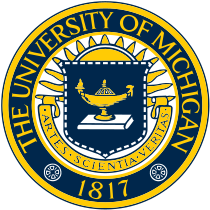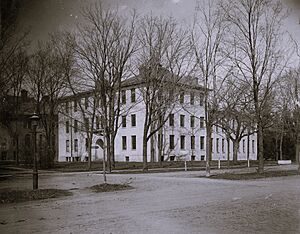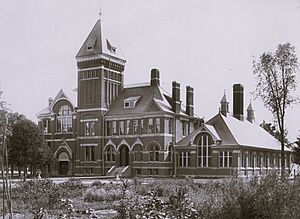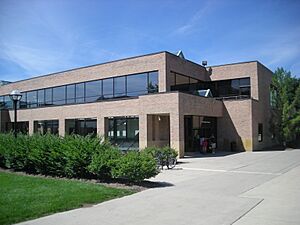University of Michigan College of Engineering facts for kids
 |
|
|
Other name
|
Michigan Engineering |
|---|---|
| Type | Public engineering school |
| Established | 1854 |
|
Parent institution
|
University of Michigan |
| Endowment | US $807.6 million |
| Dean | Karen Thole |
|
Academic staff
|
579 |
| Students | 9,682 |
| Undergraduates | 6,351 |
| Postgraduates | 3,331 |
| Location | |
| Campus | 800 acres (3.25 km2) |
The University of Michigan College of Engineering (also known as Michigan Engineering) is the engineering school at the University of Michigan. It is a public research university located in Ann Arbor, Michigan. This college helps students learn how to solve problems and create new things using science and math.
Contents
History of Michigan Engineering
The College of Engineering started in 1854. Back then, it only taught civil engineering, which is about designing and building things like roads and bridges. Over the years, the college became a leader in many new fields. It was one of the first to offer programs in data science, computer science, electrical engineering, and nuclear engineering.
The college's aerospace engineering program, which teaches about planes and spacecraft, celebrated its 100th birthday in 2014. The Materials Science and Engineering program is the oldest of its kind in the United States. In 2021, the college created the first Robotics Department among the top engineering schools in the country.
The college first started on the University's Central Campus. In the late 1940s, it began moving to the North Campus. This campus is very large, covering about 800 acres. Today, the College of Engineering is a main part of the North Campus. Other schools like the School of Music, Theatre, and Dance also share this campus. The North Campus is also home to Lurie Tower, a tall bell tower.
What You Can Study: Academic Programs
The College of Engineering offers different levels of degrees. These include Bachelor's (for students just starting college), Master's, and PhD (for advanced studies).
Here are some of the undergraduate (first-level) programs you can study:
- Aerospace Engineering
- Biomedical Engineering
- Chemical Engineering
- Civil Engineering
- Climate and Meteorology
- Computer Engineering
- Computer Science
- Data Science
- Electrical Engineering
- Engineering Physics
- Environmental Engineering
- Industrial and Operations Engineering
- Materials Science and Engineering
- Mechanical Engineering
- Naval Architecture and Marine Engineering
- Nuclear Engineering and Radiological Sciences
- Robotics
- Space Science and Engineering
The college also has special programs that offer unique courses:
- Applied Physics
- Engineering Education Research
- Macromolecular Science & Engineering
- Tauber Institute for Global Operations
- Transportation Research Institute
Labs and Cool Places to Learn
The College of Engineering has many different laboratories. These are places where students and professors do research and experiments. For example, there's the Center for Wireless Integrated MicroSystems (WIMS). This lab works on tiny electronic systems. Another lab, the Phoenix Memorial Laboratory, studies how to use nuclear technology for peaceful purposes.
The college also has 11 wind tunnels. These are used to test how air moves around objects, like cars or planes. There are also labs for electron microscopes and ion beams. You can find labs for automotive engineering, robotics, and optical sciences. A special lab for studying how water moves, called a hydrodynamics laboratory, is on the Central Campus.
The Duderstadt Center is a popular spot for engineering students. They often call it "The Dude." It has a library for art, architecture, and engineering. It also has computer labs, video editing rooms, and even virtual reality labs. It's a great place for students to work on projects and explore new ideas.
Computer services for students are provided by the Computer-Aided Engineering Network, or CAEN. CAEN runs many computer labs across the college and university.
In 2015, the University of Michigan opened a special test track called Mcity. It's a 32-acre course designed for testing autonomous cars, which are cars that can drive themselves. Mcity looks like a small town with roads, a tunnel, and even a railroad crossing. Students and professors use Mcity to work with car companies and test new vehicle technology.
In 2019, professors Elliot Soloway and Cathie Norris started the University of Michigan Center for Digital Curricula. This center creates online learning materials for students.
Top Rankings
The College of Engineering is highly respected. U.S. News & World Report ranked it as No. 7 among engineering schools in the United States in its 2021 report.
The Honor Code
Students at the College of Engineering follow an Honor Code. This is a set of rules about being honest in their schoolwork and when using computers. If a student sees someone breaking the Honor Code, they are expected to report it.
During exams, professors usually are not in the room. Students are trusted to follow the rules on their own. They are guaranteed to have an empty seat between themselves and the next person. Students can also leave and re-enter the room if needed. Before turning in an exam, students must write and sign an Honor Pledge. It says they have not given or received any unfair help.
All schoolwork must be a student's own work. If working with others is allowed, the teacher will say how much. Students must also give credit to any sources they use for ideas or quotes. Trying to copy computer programs illegally is also against the Honor Code.
If a student is suspected of breaking the Honor Code, a special group of students called the Honor Council will look into it. The student will meet with the Council. The Council then gives its decision to a faculty committee, who decides on any punishment. All records about Honor Code issues are kept private.
Student Groups and Teams
There are many student groups at the College of Engineering. Some are branches of professional organizations like the AIAA (for aerospace) or IEEE (for electrical engineers). There are also groups for minority students, like the SWE. Honor societies like Tau Beta Pi also exist. Most of these groups have offices in Pierpont Commons or the Electrical Engineering and Computer Science (EECS) building. The Engineering Student Government (ESG) represents all engineering students.
Many students join project teams where they build amazing things. These teams often work in the Wilson Student Project Center. Some major project teams include:
- University of Michigan Electric Boat
- Michigan Health Engineered for All Lives (M-HEAL)
- BLUELab
- Baja SAE Team (builds off-road vehicles)
- Concrete Canoe (builds canoes out of concrete)
- MRacing Team - Formula SAE (builds race cars)
- Michigan Mars Rover Team (builds robots for space)
- Michigan Robotic Submarine
- Steel Bridge
- Engineering Global Leadership Honors Program (EGL)
- University of Michigan Solar Car Team (builds solar-powered cars)
- University of Michigan Supermileage Team - Shell Eco-Marathon
- MFly
- UM::Autonomy
- Human Powered Submarine
- Human Powered Helicopter
The Michigan Baja Racing team is one of the best in the country. In 2013 and 2015, they won first place overall in their season. The UM Human Powered Submarine Team won the International Submarine Races in 2006. The Radio Aurora Explorer (RAX) was a small satellite designed by University of Michigan students.
Also, more than one-third of the students in the Michigan Marching Band are engineering students!
Fun Events
Tech Day is an event held every fall. High school students who are thinking about studying engineering can visit the campus. They can talk to current students and professors. They also see demonstrations and exhibits about different engineering programs.
The SWE/TBP Career Fair is a large job fair held each fall. It is organized by the Society of Women Engineers and Tau Beta Pi student groups. Nearly 300 companies come to meet students and offer jobs or internships.
The Engineering Research Symposium is a one-day event that started in 2006. Students from all levels share their research projects. They show posters, digital displays, and give presentations about their work.
See also
 In Spanish: Escuela de Ingeniería de la Universidad de Míchigan para niños
In Spanish: Escuela de Ingeniería de la Universidad de Míchigan para niños
- Engineering
- Glossary of engineering
- List of University of Michigan people – people associated with the college are marked with COE






